Unlike conventional milling, diamond milling uses single-crystal diamonds as a cutting tool, and with unique processing parameters. Dimond machining is able to achieve ultraprecise surfaces, that is, surfaces with relative figure errors <10−5 and surface roughness Sa <10 nm using single crystal diamonds as cutting tools.
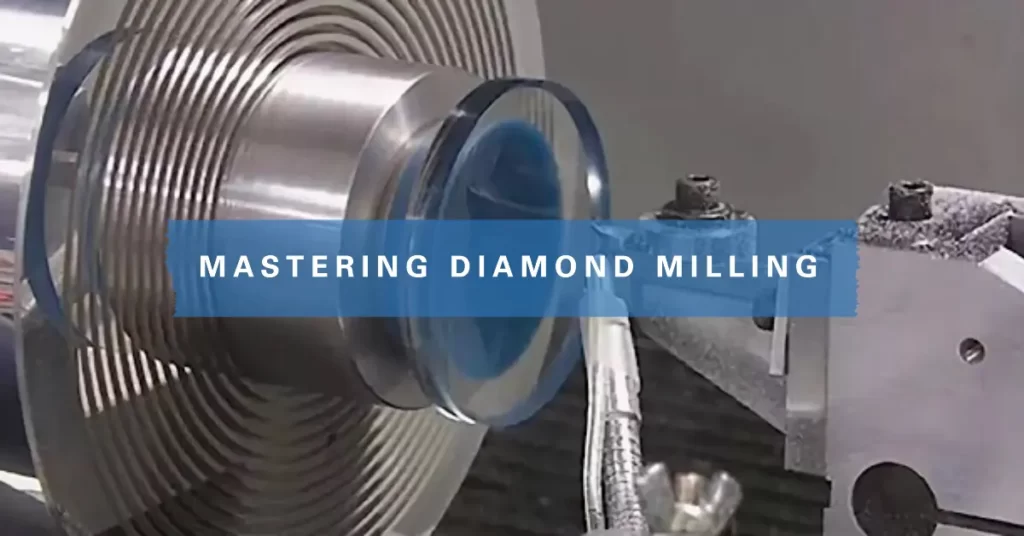
In the area of precision engineering, the diamond mill utilizes the amazing hardness of diamonds to carve, shape, and refine various materials with unmatched precision. As industries relentlessly pursue efficiency and accuracy, the incorporation of diamond mills has change manufacturing and machining processes.
This article illustrates diamond milling, its tools, applications, and the edge it provides to modern engineering.So you will be able to unstrand this process, and this might help in your future project. You can also feel free to reach out to us, we have many years of experience in this industry and are ready to serve your production needs.
The Unyielding Nature of Diamond Tools
When we think of diamonds, images of dazzling jewelry might be the first to grace our thoughts. However, beyond their mesmerizing sparkle, diamonds possess physical attributes that make them invaluable in various industries, particularly in manufacturing.
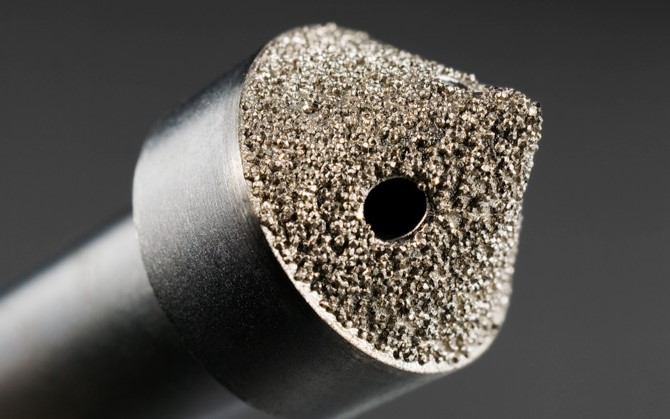
- Hardness: Diamonds are the hardest naturally occurring substance known to man. On the Mohs hardness scale, which gauges the ability of minerals to scratch one another, diamonds score a perfect 10.
- Thermal Conductivity: Remarkably, diamonds also exhibit excellent thermal conductivity, which means they can dissipate heat effectively. This trait is particularly advantageous in machining processes, preventing overheating and ensuring smoother operations.
- Low Friction Coefficient: Diamonds have a lower friction coefficient compared to many other materials. In layman’s terms, this means that diamond tools can slide across surfaces with less resistance, which leads to a cleaner, more precise cut.
- Chemical Resistance: Diamonds are chemically inert to most acids and alkalis, making them durable in diverse working environments.
Durability and Longevity of Diamond Tools
In the realm of tooling and machining, frequent tool replacements or downtimes can be a costly endeavor. However, the strength of diamonds offers a compelling solution. Diamond tools exhibit extraordinary resistance to tool wear. In many applications, a diamond tool can outlast its carbide or high-speed steel counterpart several times over.
As these tools wear down much slower, the consistency in their performance is maintained over a longer period. This means fewer deviations and reduced chances of producing subpar components. Given their longevity, machines equipped with diamond tools require fewer stops for tool changes. This, in turn, translates to increased production uptime and higher throughput.
Diamond Tools for CNC Machining
Computer Numerical Control (CNC) machining stands as a cornerstone of modern manufacturing, renowned for its precision, repeatability, and efficiency. When combined with the unmatched hardness and durability of diamond tools, CNC machining is elevated to a new echelon of performance.
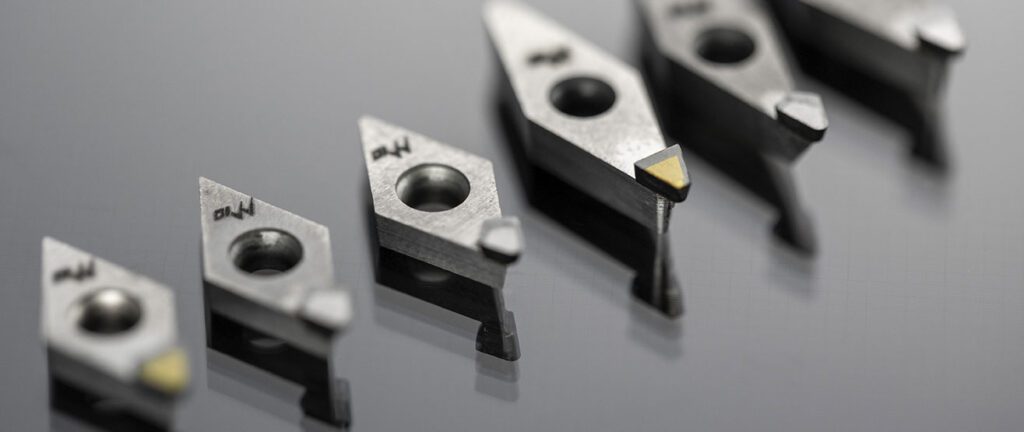
Diamond cutting tools
Diamond tools are crafted using tiny diamond particles, leveraging the natural hardness of the gemstone. When employed in CNC machining, these tools offer several pronounced advantages. For starters, the remarkable wear resistance of diamonds ensures that the tool retains its sharpness for extended periods, making it ideal for machining large batches without frequent tool changes. This longevity not only guarantees consistent quality throughout the production run but also reduces downtime, enhancing overall operational efficiency.
Furthermore, the thermal conductivity of diamonds plays a pivotal role. As CNC machines work at high speeds, heat generation is a constant challenge. Diamond tools dissipate this heat effectively, reducing the risk of material deformation and eliminating frequent pauses to cool down the equipment. Another salient feature of diamond tools in CNC machining is their ability to deliver ultra-fine finishes. Their low friction coefficient and sharpness ensure that even the most intricate and detailed designs are executed with precision and finesse.
Diamond Milling Process
Diamond milling, a specialized subdomain of machining, brings together the unyielding nature of diamonds with advanced milling processes. With the potential to significantly overhaul traditional machining paradigms, it’s crucial to grasp what sets diamond milling apart.
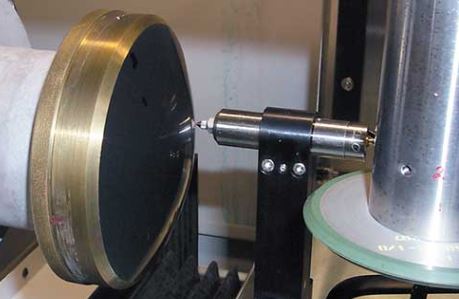
Diamond Machining
Before diving into the core of diamond milling, it’s essential to understand diamond machining as a whole. Diamond machining is a category of processes that utilize diamond tools – instruments edged with diamond particles or tips – to machine a workpiece. Given that diamond ranks as the hardest naturally occurring material on Earth, it lends itself perfectly to tasks that demand extreme precision and endurance.
The Principles of Diamond Milling
Milling, in its essence, is a cutting process where the tool rotates and brings cutting edges to bear against the workpiece, removing material in the form of chips. When you introduce diamonds into this equation, the dynamics change notably:
- Cutting Edge Precision: Diamonds provide an extremely sharp cutting edge. This edge not only enhances precision but also supports intricate design requirements.
- Low Wear and Tear: Diamonds undergo minimal wear even after extended machining durations. This characteristic ensures consistent performance throughout long production runs.
- Heat Management: Diamonds have commendable thermal conductivity. As such, they manage heat effectively, reducing the chances of workpiece deformation during extended machining sessions.
Comparison between Diamond Milling and Conventional Machining
When diamond milling against its conventional counterparts, the benefits are evident. Here’s a breakdown:
Table: Diamond Milling vs. Conventional Milling
| Aspect | Diamond Milling | Conventional Milling |
|---|---|---|
| Tool Life | Extended | Moderate to Short |
| Surface Finish | Superior | Good to Moderate |
| Initial Cost | High | Low to Moderate |
| Long-term Economics | Cost-effective | May involve frequent tool replacements |
| Material Compatibility | Wide range | Limited, based on tool material |
| Eco-friendliness | Higher (Reduced waste) | Moderate |
With industries relentlessly pursuing precision, durability, and efficiency, diamond milling presents itself as a fitting answer. Whether it’s aerospace applications demanding precision-engineered parts or the electronics sector requiring micro-components, diamond milling is poised to be a game-changer.
Mastering the Craft: Techniques in Diamond Milling
Depending on the application, the nature of the workpiece, and the desired outcome, various techniques have been developed and refined from diamond milling.
1. Single Point Diamond Turning (SPDT)
Single Point Diamond Turning is a technique predominantly used for the precision machining of non-ferrous materials. SPDT is apt for creating optical-quality surfaces.
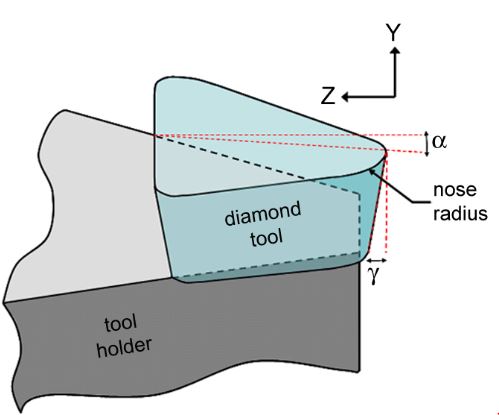
Geometry of SPDT
- Applications: Optical lenses, mirrors, and infrared systems.
- Advantages: Produces ultra-smooth finishes and is perfect for intricate designs.
2. Diamond Fly Cutting

Diamond fly cutting process
This technique employs a single-point diamond tool, but it’s primarily used for machining flat surfaces. The diamond tool skims the surface to provide a flawless finish.
- Applications: Precision flats, prisms, and mirrors.
- Benefits: Offers incredibly tight tolerances and high-quality surface finishes.
3. Diamond Drilling

Harnessing diamond’s extreme hardness, this method is used to drill into super-hard materials that conventional drills can’t manage.
- Applications: Gemstones, ceramics, and certain aerospace materials.
- Advantages: Precision drilling with minimized tool wear.
4. Diamond Grinding
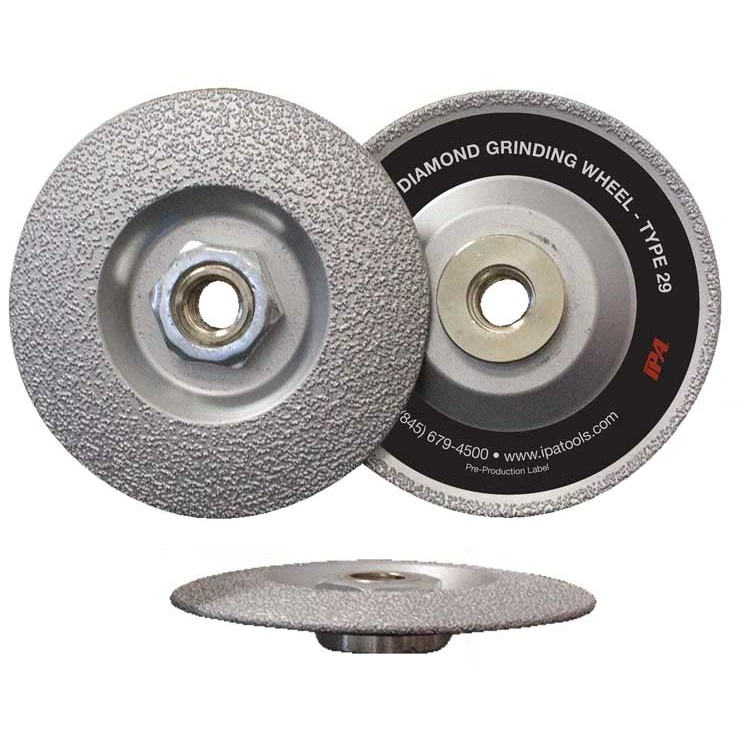
Diamond grinding uses the hardness of a diamond to grind, shape, and smooth surfaces.
- Applications: Precision ceramics, glass, and hard metals.
- Perks: Provides refined finishes and works for intricate, delicate pieces.
5. Diamond End Milling
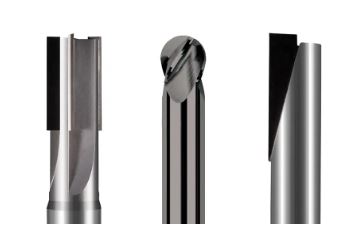
Diamond end-mills
Here, a rotating multi-toothed tool is employed. The process involves a mix of drilling and peripheral cutting.
- Applications: Deep cavities, complex shapes, and profiles in hard materials.
- Benefits: Rapid material removal, and versatility in design capabilities.
Table: Quick Comparison of Diamond Milling Techniques
| Technique | Key Application | Major Advantage | Best For |
|---|---|---|---|
| SPDT | Optical systems | Ultra-smooth finishes | Intricate designs |
| Fly Cutting | Precision flats | Tight tolerances | Flat surfaces |
| Diamond Drilling | Gemstones, ceramics | Precision in hard materials | Drilling tasks |
| Diamond Grinding | Glass, hard metals | Refined finishes | Smoothing surfaces |
| End Milling | Complex shapes | Versatility | Rapid material removal |
Selecting the Right Diamond Milling Technique
Choosing the right diamond milling method hinges on several considerations, ensuring precision, efficiency, and quality. Understanding your project requirements is the cornerstone to tapping into the full potential of diamond milling.
- Material Characteristics: Different materials exhibit distinct properties. For instance, brittle materials may require a more delicate approach, while harder substances can withstand more aggressive techniques.
- Desired Outcome: It’s essential to have clarity about the finish and quality desired. If a super-fine finish is the aim, certain techniques will outshine others.
- Geometrical Complexity: Detailed, intricate designs might lean towards techniques allowing greater precision, while broader surfaces may employ a more generalized method.
- Tolerance Levels: High-precision tasks, especially in industries like aerospace or medical devices, demand techniques that offer tight tolerances.
Table: Technique Selection Guide
| Criteria | SPDT | Fly Cutting | Diamond Drilling | Diamond Grinding | End Milling |
|---|---|---|---|---|---|
| Material Hardness | High | Medium | High | High | Medium |
| Surface Finish | Ultra-smooth | Smooth | Variable | Refined | Standard |
| Design Complexity | High | Low | Low | Medium | High |
| Tolerance Levels | Ultra-tight | Tight | Moderate | Tight | Standard |
The Applications: Multifaceted Uses of Diamond Milling
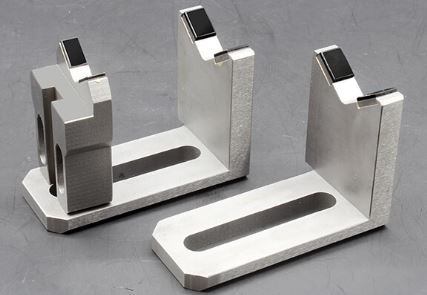
Parts created with diamond milling
Dimond milling has been used in various industry. The following chat shows some common industry applications of Dimond milling.
Table: Comprehensive Overview of Diamond Milling Applications by Industry
| Industry | Key Applications | Reasons for Use | Benefits | Examples |
|---|---|---|---|---|
| Aerospace & Aviation | Crafting specialized aero-engine components, Manufacturing landing gear systems, Creation of intricate satellite parts. | Need for extreme precision, Stringent safety standards, Durability requirements. | Enhanced safety, Extended component lifespan, Ultra-smooth finishes. | Wing flaps, Landing gear pins, Satellite panels. |
| Electronics & Semiconductors | Silicon wafer dicing and production, Structuring of semiconductor substrates, Micro-grooving for microfluidic chips. | Emphasis on miniaturization, High precision essential for component functionality, Micro-chipping prevention. | High yield of components, Enhanced device functionality, Precision in miniature parts. | CPU chips, Memory sticks, LED structures. |
| Medical Devices & Equipment | Creation of dental tools and orthodontic devices, Manufacturing precision surgical instruments, Development of diagnostic devices. | High precision required for fit and function, Sterility needs, Need for sharp and durable tools. | Improved patient outcomes, Enhanced tool lifespan, Sterility assurance. | Surgical scalpels, Dental braces, MRI machine components. |
| Jewelry & Gem Crafting | Precision cutting of diamonds and gemstones, Crafting intricate metal bases for stone settings, Detailed engraving on precious metals. | Requirement for dazzling gemstone cuts, Need for intricate designs on metals, Consistency across multiple jewelry pieces. | Enhanced gemstone brilliance, Increased design capabilities, Consistent quality across pieces. | Diamond engagement rings, Gold necklaces, Platinum bracelets. |
| Automotive Industry | Production of engine components, Crafting decorative elements for vehicle interiors, Manufacturing of brake systems. | Need for high durability parts, Precision manufacturing for tight tolerances, Superior finishes on components. | Longer vehicle lifespan, Enhanced vehicle aesthetics, Safety assurance. | Engine pistons, Leather seat designs, Brake rotors. |
What Are the Advantages of Diamond Milling?
Machining has seen significant advancements with the introduction of diamond milling. Using the exceptional qualities of diamonds, this method provides a range of advantages that are setting new benchmarks in various industries.
- Superior Surface Finish: Diamond milling ensures surfaces of impeccable smoothness. This often negates the requirement for subsequent finishing stages. With such refined surfaces, components benefit from reduced friction, which in turn enhances their operational efficiency and lifespan.
- Extended Tool Longevity: The unmatched hardness of diamonds ensures that tools last significantly longer. This resilience translates to fewer instances of tool replacements, leading to considerable cost savings over time.
- Unwavering Precision and Accuracy: With the capability to achieve precision down to the micron level, diamond milling becomes indispensable for applications demanding utmost accuracy. Every component crafted through this method adheres rigorously to its design specifications, maintaining uniformity throughout the production process.
- Swift and Efficient Material Removal: Diamond milling stands out for its rapid material removal capabilities. And this doesn’t come at the cost of quality or precision. Moreover, diamonds excel in machining hard and abrasive materials, which can quickly deteriorate conventional tools.
- Augmented Durability of Components: The finished components, thanks to minimal tool marks and imperfections from diamond milling, inherently resist wear and tear more effectively. Furthermore, the precision of the milling process ensures minimal internal stresses, fortifying the structural integrity of the components.
- Remarkable Versatility: Diamond milling’s prowess isn’t restricted to a narrow band of materials. It is proficient at machining an expansive spectrum, from metals and ceramics to gemstones and select polymers. Additionally, the exactness of diamond tools allows them to carve out intricate geometries, a trait indispensable for complex design implementations.
- Environmentally Considerate: The sustainability factor comes into play with diamond tools. Their extended lifespan means reduced replacements, leading to diminished waste. The efficiency associated with diamond milling also means less energy consumption per unit produced, further underlining its eco-friendly nature.
Prolean’s Diamond Machining Services
Prolean emerges as a harbinger of excellence with its state-of-the-art Diamond Machining Services. Embracing innovation and harnessing the unparalleled capabilities of diamond tools, our commitment is evident in every facet of its services.
Table: Prolean’s Diamond Machining Services Overview
| Feature | Description |
|---|---|
| Cutting-Edge Technology | Prolean stays updated with the latest advancements in diamond milling technologies, ensuring clients always benefit from unparalleled precision and accuracy. |
| Unwavering Commitment to Quality | Prolean’s rigorous quality assurance protocols ensure each component undergoes meticulous checks, often surpassing industry standards. |
| Skilled Craftsmanship | A unique blend of advanced machinery and seasoned professionals ensures that even intricate designs are realized with unmatched precision. |
| Versatility in Applications | Catering to a wide range of industries, from aerospace to jewelry, Prolean’s extensive portfolio underscores its adaptability and proficiency. |
| Sustainability at the Forefront | With a focus on the longevity of diamond tools, Prolean contributes to reduced waste and energy consumption, aligning with global sustainability objectives. |
| Tailored Solutions | Recognizing the uniqueness of each client’s needs, Prolean adopts a consultative approach, tailoring the diamond machining process to the specific requirements of each project. |
| Transparent Client Engagements | Valuing every client as a partner, Prolean maintains open communication channels to keep clients updated about project progress, challenges, and solutions. |
| Cost-Effective Excellence | By emphasizing efficiency and leveraging the long-lasting nature of diamond tools, Prolean offers competitive pricing structures, ensuring that clients receive outstanding quality without breaking the bank. |
Conclusion
The diamond mill stands out as an embodiment of technological innovation, blending natural of diamonds with the CNC Milling technique. Its unmatched durability, precision, and cost-efficiency have made it an indispensable tool in modern manufacturing. While there are challenges associated with its adoption, the advantages it brings to the table cannot be overlooked.
FAQs
What is a diamond mill?
A diamond mill refers to a milling tool embedded with diamonds, utilized for its unparalleled hardness and precision in machining.
How does diamond milling compare to conventional milling?
Diamond milling offers greater precision, durability, and often a superior surface finish compared to conventional milling.
Are diamond mills suitable for all materials?
While incredibly versatile, diamond mills are particularly advantageous for certain materials like aluminum and hard substances. However, they may not be ideal for all applications.
Is the initial investment for diamond milling high?
While diamond milling tools can have a higher initial cost, their durability and efficiency often result in long-term savings.
What are the primary advantages of diamond milling?
Diamond milling offers a superior surface finish, reduced tool change downtime, exceptional durability, and long-term cost efficiency.
Why choose Prolean’s Diamond Machining Services?
Prolean offers state-of-the-art diamond machining infrastructure, a wide range of solutions, and a commitment to excellence, ensuring top-notch service for diverse applications




Very interesting! But, don’t the diamond tooling significantly increases the production cost?
Yes, diamond tooling can increase production costs due to its higher initial investment. However, its exceptional durability, precision, and ability to handle tough materials reduce the need for frequent tool changes, resulting in long-term savings. It also improves surface finishes and machining efficiency, which can outweigh the upfront costs in high-volume or specialized applications.